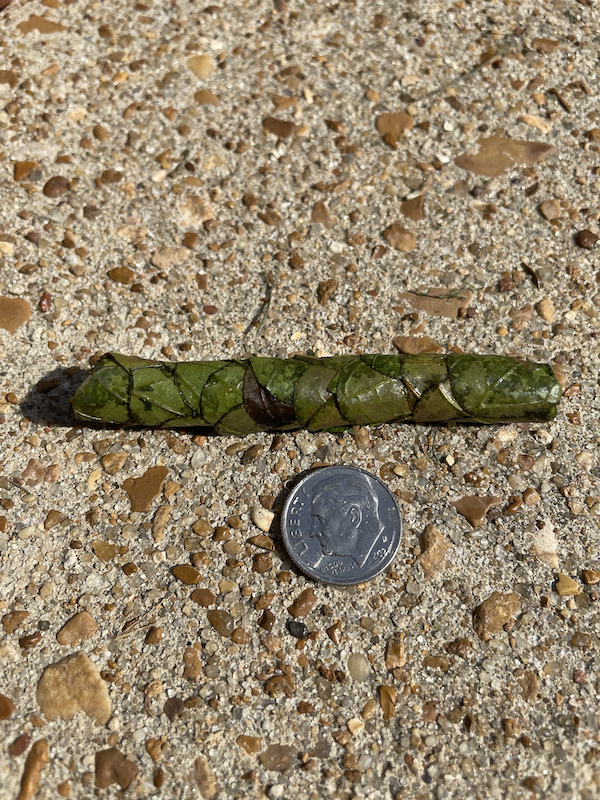Leafcutter Bee, Vol. 8, No. 13
Leafcutter Bee
Order: Hymenoptera
Family: Megachilidae
“When I turned on the garden hose, it swelled, jumped, sputtered, and spit out this cigar-looking plug of leaves. It was composed of a series of cells, stacked end to end and each filled with something yellow. This was not in there when I used that hose a couple days earlier. What is this thing?”
Leafcutter bees are solitary bees that build their nests in elongate holes of appropriate size. Unlike carpenter bees, they do not bore holes themselves. In nature they nest in hollow plant stems or holes abandoned by wood-boring insects, but they will also use drill holes and similar cavities in man-made objects. There are many species and they vary considerably in size, which means the preferred hole size also varies. The bee that built this nest is about the same size as a honey bee but black in color.
Apparently, the inside of a garden hose is just right for this bee; I have had them plug hoses at my house on several occasions. Normally, this is not a big problem, as the plug pops out when the water is turned on. But if some type of spray nozzle is screwed onto the hose beforehand you get no water.
Leafcutter bees line their nests with small discs of leaves they cut from plants such as roses, red buds, ash, and many other plants. You have probably noticed a rose or other plant with perfectly round holes cut in from the margins of the leaves. They look like they have been stamped with a tiny round cookie cutter. This relatively small amount of leaf loss is usually not harmful to the plants. The bees use these leaf discs to build hollow cells, which they fill with pollen and then lay a single egg per cell. Of course, nest size partly depends on the depth of the hole, but it is not uncommon to find nests that are six to eight cells deep. They don’t store honey in these cells, just a mixture of pollen and nectar as food for the developing larvae.
Leafcutter bees are also unusual in how they collect and carry pollen. Honey bees, bumble bees, and many other bees carry pollen in special “pollen baskets” on their rear legs. You have probably seen both honey bees and bumble bees carrying heavy loads of orange or yellow pollen in this way. Leafcutter bees have no pollen baskets. Instead, they carry pollen on the underside of their abdomen, which is equipped with a patch of special hairs. Pay close attention to foraging bees this summer and you will probably see some with yellow, pollen-loaded bellies.
Does this mean leafcutter bees are good pollinators? Yes, these solitary bees are efficient pollinators of many crops. Some gardeners and farmers even go so far as to purchase or build special nesting sites for leafcutter bees, as well as mason bees, which belong to the same family, but use mud, rather than leaves to build their nests. Two advantages of using these solitary bees as pollinators for smaller areas are that they are less likely to cause stings and they forage much closer to home than honey bees.
Thanks to Mr. Dwight Austin for sharing this recent photo and his experience with his plugged garden hose.
Grass-carrying wasps build their nests in similar cavities and line them with plant material, but these predatory wasps provision their nests with crickets, rather than pollen.
Blake Layton, Extension Entomology Specialist, Mississippi State University Extension Service.
The information given here is for educational purposes only. Always read and follow current label directions. Specific commercial products are mentioned as examples only and reference to specific products or trade names is made with the understanding that no discrimination is intended to other products that may also be suitable and appropriately labeled.
Mississippi State University is an equal opportunity institution.
Bug’s Eye View is now on Facebook. Join the Bug's Eye View Facebook group here.


